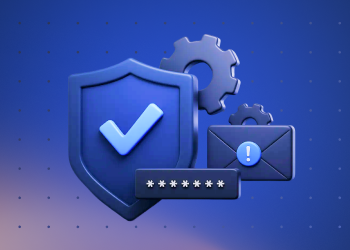While MSP best practices involve a set of performance management around the security and compliance, the real success of a Managed Service Provider (MSP) business hinges in large part on two key criteria:
- Efficiency
The more streamlined any MSP’s internal processes are, the better it can support customers and the more profits it can generate.
2. Security
MSPs must also be able to deliver managed services with a high degree of security. Without protecting client data and maintaining security and compliance, MSPs are likely to lose customers and revenue.
Unfortunately, these goals can be tough for some MSPs to achieve in tandem. A heavy focus on security and compliance can slow down operational efficiency, while MSPs who fixate too much on fast processes risk making security mistakes.
The good news is that it’s possible to square this circle. By adopting the right practices, MSPs can have it all – meaning they can operate efficiently while also keeping data safe and mitigating security risks.
Read on for tips on MSP best practices, as we unpack key best practices for modern MSPs. We’ve broken the practices into categories, each aligned with different areas of responsibility that MSPs must typically handle.
Core MSP Best Practices for a Strong Operational Foundation
Let’s start with the most basic practices every MSP should embrace to lay the groundwork for operational efficiency. They include:
Standardized processes
MSPs should strive to follow consistent, standardized routines across all aspects of their business – from delivering client support, to employee onboarding, to ransomware response and beyond.
Centralized management
Centralized management breeds efficiency by allowing MSPs to work using a single platform and location. MSPs should select software tools that include features like remote monitoring and management (RMM) so they can support customers without having to travel on-site. Routines like reporting, endpoint management and patching operations should also occur through centralized systems.
[notebox] Explore unified MSP software in a single pane of glass: MSP360 Platform is a centralized, all-in-one IT management and data protection platform for MSPs, that combines MSP360 Managed Backup, MSP360 Managed Backup for Microsoft 365 and Google Workspace, MSP360 RMM, and MSP360 Managed Connect under one management console for MSPs.
MSP Best Practices: Automation
Automation is also a key ingredient in efficiency. Automating recurring tasks like patching, endpoint checks and report generation not only saves time and reduces toil for staff. It also helps to reduce the risk of errors or oversights, which are more likely to occur during manual operations.
Security and Compliance Best Practices
As far as security and compliance concerned, the following best practices help ensure MSP success:
Multi-layered security
Because there is no way to guarantee completely that a breach will never occur, MSPs should adopt a multi-layered security strategy (sometimes called defense-in-depth) that provides multiple levels of protection: Physical security, network security, device security, data security and so on. The more defensive lines MSPs erect, the harder they make it for attackers to breach systems.
Regular vulnerability assessments
Rather than waiting for attacks to occur, MSPs should proactively perform vulnerability assessments by checking for unpatched software and insecure configurations.
Compliance-ready backup and workflows
Compliance mandates that apply to MSPs often require security to be built into processes and workflows. For example, in the context of data backup, MSPs may need to be able to ensure that backup data is secure (to protect sensitive information inside backups). They may also face a mandate to generate reports that demonstrate the compliant status of their operations.
How MSP360 Helps MSPs Achieve Security and Compliance Best Practices
MSP360 considers security a core priority, and we do our utmost to protect your information with all our solutions. We keep your data safe and secure with a wide range of mechanisms for the ultimate data protection strategy.
First, you can prevent backup data from being altered, deleted or corrupted by ransomware with the additional GFS retention settings available for Amazon S3, Wasabi and Backblaze B2 storage providers called Object Lock (Immutability). Object lock is the ultimate insurance policy against ransomware attacks that is currently available. Second, our MSP backup software implements end-to-end encryption, audit logging, advanced retention settings, 2FA, and multi-level access control, ensuring your backups are compliance-ready.
- Cross-platform backup and recovery
- Flexible licensing
- Bring-your-own storage approach


Enhanced Data and Protection Best Practices
Any MSP can back up data. But to do so efficiently and securely, MSPs need to think beyond basic backup and data protection practices. They should also adhere to concepts like the following:
3-2-1-1-0 backup rule
This practice, which refers to the way MSPs store and configure backup data, minimizes the risk that attackers will compromise backups or that recovery operations will fail.
Further reading 3-2-1-1-0 Backup Rule: Extend Your Backup Security
Regular backup monitoring
You don’t want to wait until recovery is underway to discover that your backups have a problem and can’t be used. Backup monitoring helps to prevent this risk by keeping MSPs abreast of the status of backups and proactively alerting them to issues like failed or incomplete backups.
Backup testing is a cornerstone on MSP best practices
For similar reasons, it’s a best practice to test backups regularly. This is another way of identifying backup issues proactively.
Secure backup access controls
Backups can contain sensitive data. In addition, ransomware attackers sometimes target backups for deletion, knowing that if they destroy backups, they are more likely to force their victims to pay ransom. Access controls for backup data reduce both risks by restricting who can access and modify backups.
Document processes
Backup processes and routines should be extensively documented to ensure that all relevant employees know what’s being backed up, how it’s backed up and how to use backups for recovery. The easier it is to find information like this, the more efficiently and quickly MSPs can perform backup and recovery operations.
Backup considerations for Microsoft 365 and Google Workspace
Cloud-based platforms, like Microsoft 365 and Google Workspace, don’t prevent accidental deletion, misconfigured retention, or tenant-level compromise. According to the Shared Responsibility Model, the service provider is responsible for the availability of the platform, and the user is responsible for the data they put into it. For MSPs, this means the necessity of a separate, independent backup for M365/Google.
How MSP360 Helps MSPs Achieve Data Protection Best Practices
MSP360 offers a suite of robust backup solutions that contribute to building an efficient and reliable data protection strategy.
MSP360 cloud backup solutions helps you to follow the 3-2-1-1-0 rule seamlessly. It supports multiple storage destinations and allows you to implement the bring-your-own storage approach by choosing the cloud storage provider of your choice. This helps you to comply with two of the requirements, where the first one is about storing data copies across at least 2 storage types, and the second one is about locking one dataset from alterations or deletions. This can be done with the object lock, a feature that is supported across all MSP360 Backup products when using AWS, Wasabi Hot Cloud Storage, and Backblaze B2.
Another important feature of MSP best practices, which is available across all backup solutions is built-in backup testing called Restore Verification and Consistency Check: these features help you to test backup recoverability and ensure that data in storage remains unmodified.
MSP360 Managed Backup also helps users with monitoring and reporting: in the MSP360 web console, you can track your users’ backup and restore activities with a high level of detail. You can review failed backups, check backups with warning statuses, and analyze backup trends. These insights help you identify patterns and prevent recurring issues.
Security is also a top priority for us: with MSP360 Managed Backup, you get multi-layered protection designed to keep your data safe, your access secure, and your business running smoothly with backup encryption, custom roles and permissions, 2FA, IP allowlisting, and more.
For MSPs who manage M365 and Google environments, MSP360 provides a cloud-to-cloud SaaS backup solution that simplifies deployment, minimizes infrastructure overhead and ensures data is always recoverable.
Customer Service MSP Best Practices
Businesses hire MSPs because they want efficient, reliable service. To deliver it, MSPs should embrace best practices like the following:
MSP Best Practices: Proactive communication
Don’t wait until something goes wrong, or your customers ask for a status update, to tell them what you’re doing. Keep them abreast of operations proactively. They’ll appreciate the communication, and will be more likely to trust you to provide great service.
Training and education
Another way to build client trust and keep customers informed about what you are doing for them is to offer training and education where relevant. For instance, if you offer ransomware protection services, providing anti-phishing training to your clients’ employees could help to reduce the risk of a ransomware attack, while also highlighting your competence and proactive engagement as an MSP.
MSP Best Practices: Transparent SLAs
Define clear Service Level Agreements (SLA), meaning the contracts that specify which level of service you’ll deliver as an MSP. Transparent SLAs benefit your business as well as your customers by setting clear expectations.
Managing Pricing and Service Offerings
From a pricing and service offering standpoint, these best practices can help MSPs to maximize value for clients while also optimizing profitability for MSPs:
Value-based pricing
While there are multiple MSP pricing strategies to consider, value-based pricing is often ideal. By linking pricing to the value that customers receive, it rewards MSPs based on the quality of the services they deliver while leaving clients with the feeling that they are getting maximum value.
Variety and flexibility
Consider offering multiple tiers or packages at different price points. For instance, you might give customers the option of choosing from varying cloud storage options. This makes it easier for each client to find a service package aligned with its needs and budget.
MSP Best Practices for Performance Management
The final essential set of best practices for MSPs centers on performance management. You can’t understand the state of your business and find ways to optimize if you don’t effectively track what you’re doing and where you may be able to improve. Toward that end, consider:
Essential KPIs for the business, according to MSP best practices
Identify which key business performance indicators (KPIs) to track in areas like finance or sales. These metrics provide critical insight into how well your business is operating and achieving its goals.
Technical metrics
Alongside business KPIs, MSP best practices involve also monitoring technical metrics, such as backup success and failure rates, mean ticket resolution times and system uptimes. Here again, you can use these metrics to determine where you’re succeeding and falling short, and to identify opportunities for improvement.
Collect feedback
Determine what your customers think of the services you’re providing by distributing surveys and keeping communication channels open. This is another way to be proactive about customer engagement and get ahead of issues before they snowball into crises.
Conclusion On MSP Best Practices
Again, being both an efficient MSP, and one that meets key obligations in the areas of security and compliance, is not always easy. But it’s eminently feasible when you embrace best practices like those described above, which offer a balanced approach to operating an MSP business that maximizes value for everyone involved – clients and the MSP.





